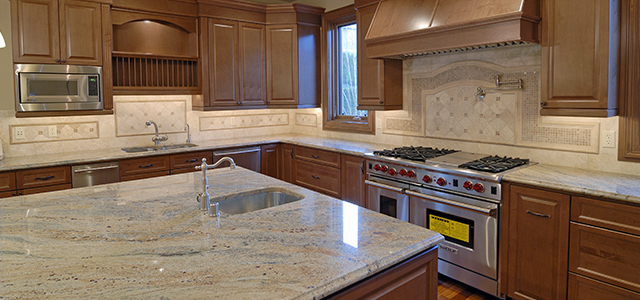Choosing a granite countertop isn’t easy. Each granite slab is unique, which means you’ll have to look at tons of slabs just to get a sense of what’s out there. As you peruse the samples in your local fabricator’s warehouse, keep these tips in mind to make easy work of selecting a counter:
- Color. Here’s where the rubber meets the road: The variety of granite colors from which to choose can be overwhelming. However, you can narrow down color choices before you hit the warehouse if you land on a few options beforehand. Consider the décor of the entire home when designing your kitchen, but also keep cabinet color in mind. You have two general choices when considering colors. You can choose the same countertop color as the cabinets, which will enhance a modern, contemporary look. Alternately, the countertop color can contrast with the cabinet color, providing interest. Granite slabs also have their own unique look due to the speckled or veined nature of the piece. It’s also possible to choose a solid color.
- Thickness. There are two general thickness from which to choose for your countertops. The right thickness depends greatly upon the counter’s purpose and where it’ll go in the home. A thinner granite slab that’s ¾ inches thick needs supports for edges and overhang; without them, the edging will look unnatural. Thicker granite slabs, or those that are 1 and ¼ inch in thickness, are heavier; as a result, a single, uncut length of counter can go on for a longer distance than a thinner slab can. Both thicknesses can work in a bathroom or kitchen. The right slab really depends on the length of the counter and whether the location can feature the necessary supports for thinner slabs.
- Edging. Most manufacturers offer a couple of standard edging options at no cost to their customers. However, there are tens of edging choices from which to choose. The edge is the “profile” of the slab, or the piece of granite you see when facing the countertops. The edging should provide interest, and its shape can further promote a distinct design feel in the kitchen. A rolled edge, for example, is very smooth and rounded. On the other hand, a straight edge has a boxier feel, with 90 degree angles at the top and bottom. In between, there are options like the half bullnose edge, which is rounded at the top and has a 90 degree angle at the bottom.
- Backsplash and sink. One of the final factors you should know about when choosing a granite counter, the sink’s style will dictate whether you can feature a seamless counter. Under-mounted sinks allow for the feature, whereas drop-in sinks don’t. In addition, the backsplash presents further options. You can simply continue the same granite slab material up the backsplash, to the standard 4 inch height. Or you can take the backsplash right up to the upper cabinets and employ a contrasting design.
When it comes to choosing a granite counter, there’s lots to consider. If you’re facing these decisions, talk to an expert. Professional granite fabricators can walk you through the many color, pattern and design choices and let you see granite slabs up close and personal. You should also evaluate the advantages and drawbacks of the standard granite slab thicknesses and choose an edging. Finally, consider which kitchen sink and backsplash styles will further boost the aesthetic of your new kitchen space.


